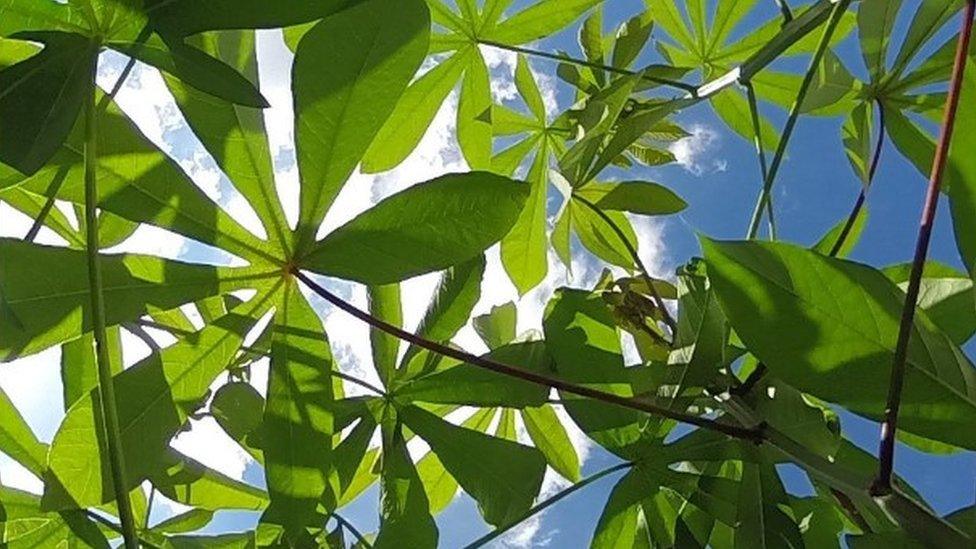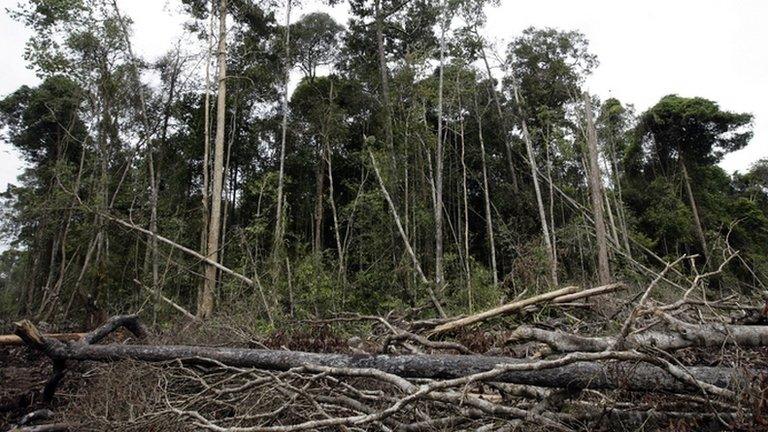Genetic breakthrough: Crops use more sunlight to grow
- Published
How scientists made plants produce more food from sunlight - a key step in feeding the growing global population.
Scientists have improved "the most important biological process on the planet" - photosynthesis.
The breakthrough, published in the journal Science, external, used genetic modification to increase the amount of sunlight energy crop plants can channel into food production.
That increased yield in an experimental crop by 15%.
Researchers say this is a critical step towards increasing crop production to feed a growing global population.
Lead researcher Prof Stephen Long, based at the the University of Illinois and the University of Lancaster, said decades of research into the 140-step process by which plants convert sunlight energy into food had revealed specific "inefficiencies in crops".
"There are bottlenecks holding up the conversion of sunlight energy into food," he told BBC News.
"Our research has tackled one of those bottlenecks."

Researchers targeted a plant's inbuilt Sun-protection mechanism
The scientists targeted a plant's natural Sun-protection mechanism - while plants have evolved to produce food using sunlight energy, they have also evolved to protect themselves from Sun damage, which slows the process down.
"[To protect itself], the leaf induces a process that gets rid of excess energy as heat," Prof Long told BBC News.
"But the problem is when a cloud moves across the Sun, there's less sunlight energy - the plant could use it all, but it carries on dispensing that energy as heat.
"So what we've done is speed up the process by which that heat loss [switches off]."
The team inserted extra copies of the genes responsible for this heat-loss switch.
And when they then grew their genetically modified crop, it grew 15% larger than normal.
"This is a big jump," said Prof Long.
"Well, we're now making this change in rice, in soy bean and wheat; [15% in those] would be huge.
"Globally - rice, wheat, maize and soybean are the biggest crops.
"So if we could get the same increase in those, that would greatly alleviate what we see as the future pressure on food supply. "
Feeding the nine billion
That pressure will intensify in the coming few decades, according to the United Nations Food and Agriculture Organisation (UNFAO).
By 2050, it projects, the world will need to grow 70% more food, as the global population rises to more than nine billion people.
"At the current rate we're not going to come close to reaching that target, so we're really in desperate need of new innovations," said Prof Long.
"For us [in the West], food prices will go up.
"But for some of the poorest nations, many households are already spending almost 100% of their household income on food, so for those families and those countries, this will be a catastrophe."
Dr Hans Dreyer, from the UNFAO's of the plant production and protection division, said: "This is just one change, and we don't yet know if these plants will require more of other resources like water.
"It's really important to increase crop yields significantly, but also sustainably."
Prof Christine Foyer, who directs a food security project for Sub-Saharan Africa at the the University of Leeds, described the breakthrough as "vital".
"In terms of making Africa green and solving the problems associated with agriculture in those parts of the world," she told BBC News, "improving the processes involved in photosynthesis is an important step in solving food security.
"Many people in the world today don't get enough to eat. And it's possible to envisage, with these new developments, that we can achieve zero hunger within the next 20 years.
"I would hope that poor farmers would have plants that would grow well across a wide range of environmental conditions. So if you end up in drought or flood, you could have crops that remain viable.
"Giving people with very little the wherewithal the feed themselves, that's what matters."
This research involved collaborators from the Polish Academy of Sciences and the University of California Berkeley.
- Published18 July 2016

- Published25 June 2014
